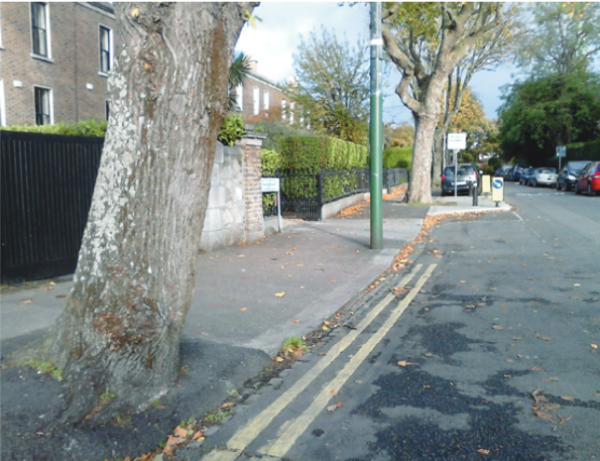
Rodney Devitt
Probably everybody who lives in Sandymount has walked up Leahy’s Terrace at some point, from Sandymount Road to Beach Road, by the side of Star of the Sea Church. And there, set into the footpath, starting at the Sandymount Road end, are five fine mature trees, which must be at least one hundred and thirty years old, each about twenty yards apart, and stretching the length of that fine terrace of early Victorian houses. Well, four actually, since one must have succumbed to some ailment, and was replaced by a younger model, maybe sixty years ago. But these five trees – one London Plane and four Poplars – achieved literary fame when James Joyce’s earth-shaking novel Ulysses was published 100 years ago.
The novel is set over one day, the 16th June 1904, though it was not actually published until eighteen years later, in 1922. Joyce picked that date to coincide with the time he was actually staying in a house on Dromard Terrace in Sandymount, and brought his girlfriend and life-partner-to-be, Nora Barnacle, for a walk out to the Shelly Banks.
As all NewsFour readers will be only too aware, Ulysses contains three important episodes that are set in Sandymount. The first one brings one of the main characters, Stephen Dedalus, to our fabled seafront, where he has a long and complicated debate with himself on all sorts of philosophical and metaphysical matters, and of course utters, with his eyes closed, the immortal words: “Am I walking into eternity along Sandymount Strand?”
The Hades episode begins at number 9 Newbridge Avenue, outside which is a horse-drawn hearse in which poor Paddy Dignam, the late occupant of said number nine, who has died from drink-induced apoplexy, is to be brought to Glasnevin Cemetery.
And finally, the third Sandymount based episode takes place at about eight o’clock in the evening, when our main protagonist, Leopold Bloom, who has been to visit Paddy Dignam’s widow to help her with a widow’s insurance policy, walks from Newbridge Avenue, up Leahy’s Terrace, and down onto the Strand to sit on a rock, enjoy the evening sun, and ponder on his stressful day around the city.
The opening passage of this chapter is one of the most beautiful in the whole book:
“The summer evening had begun to fold the world in its mysterious embrace. Far away in the west the sun was setting, and the last glow of all too fleeting day lingered lovingly on sea and strand, on the proud promontory of dear old Howth, guarding as ever the waters of the bay, on the weedgrown rocks along Sandymount shore and, last but not least, on the quiet church whence there streamed forth at times upon the stillness the voice of prayer to her who is in her pure radiance a beacon ever to the storm-tossed heart of man, Mary, Star of the Sea.”
It is almost prayer-like in its sublime depiction of this lovely area. Or it could be an estate agent’s advertisement in the property pages of a newspaper.
We should be aware that in 1904, Beach Road did not exist, the sea wall was much closer to the Church than it is now, and what was then the Strand is now Sean Moore Park and sports ground. As in the whole book, Joyce was meticulous in presenting the accurate geography and topography of his native city, from which he had by now exiled himself. For one small section of the Sandymount Strand episode, he wrote home from Trieste, where he and Nora were then living, to his aunt in Dublin: “Dear Aunt Josephine, I want that information about the Star of the Sea Church. Has it ivy on its seafront? Are there trees in Leahy’s Terrace at the side or the rear? If so, what and how many? Are there steps leading down to the beach?”
Poor Aunt Josephine, who lived on the north side of the city, presumably had to get the number three tram to Sandymount and, with her little notebook and pencil, record all that her demanding nephew asked for. And a very good job she must have made of it, because the picture we get of that part of Sandymount on a warm summer’s evening in 1904 is totally credible.
“Soon the lamplighter would be going his rounds past the Presbyterian church grounds and along by shady Tritonville road where the couples walked, and lighting the lamp near her window From house to house, giving his ever welcome double knock, went the nine o’clock postman, the glow worm’s lamp at his belt gleaming here and there through the laurel hedges And among the five young trees a hoisted limstock lit the light at Leahy’s Terrace.”
Almost makes you wish you lived in Sandymount a hundred years ago.



